Benchmarks - 1080p and 1440p
Our 1080p and 1440p tests consist of more classical synthetic and real world gaming tests which enable us to compare different platforms (CPU and GPU) easily. We are therefore able to include results for the Radeon R9 290X GPU, AMD's flagship competitor to the GTX 980 and for the time being the TITAN X too.
Due to our 290X sample dying prematurely , we do not have a complete set of competitive scores for it.
Furmark, 3D Mark, Unigine Heaven/Valley
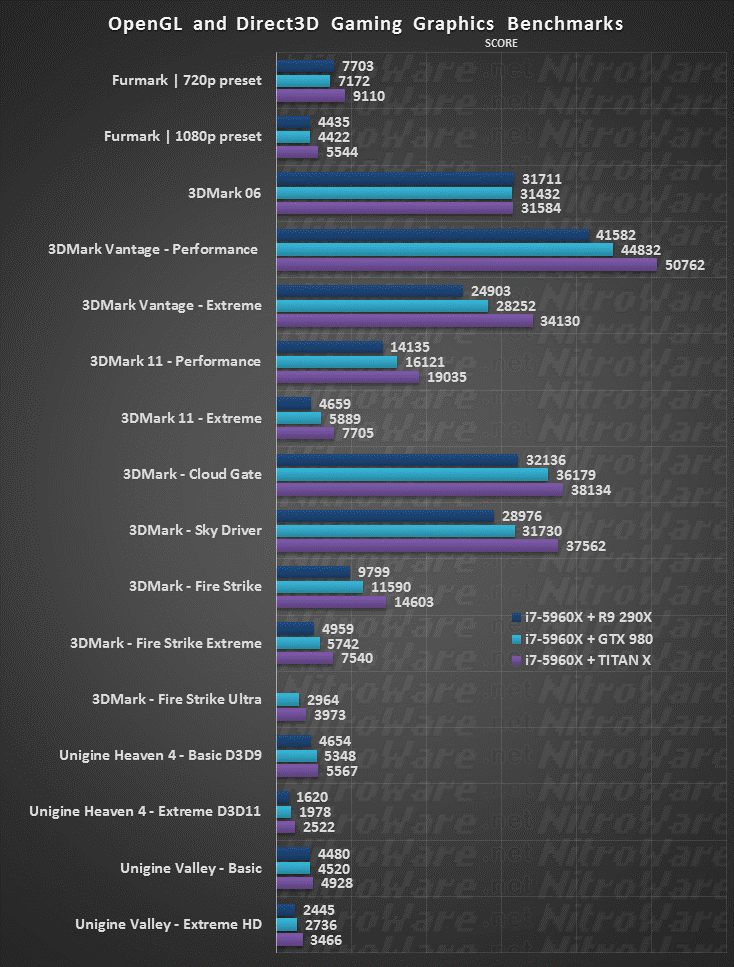
We do not 'play' 3DMark, but the overall performance advantage TITAN X paints a pretty picture (pun unintended), as with our 4K gaming tests, we also see up to 30% increase against the 290X and 20% for the GTX 980. We include Furmark as an OpenGL performance test.
Consider the following when looking at these results.
- GPU memory bandwidth: R9 290X 320 GigaBytes/s, GTX 980 224 GB/s, TITAN X 336 GB/s
- CPU clock speed, Unigine can be sensitive to small changes
- Older versions of 3Dmark are mainly included for reference and should not be used to solely evaluate performance of new hardware, as well as being more CPU reliant.
- 3DMark Firestrike includes a PHYSICS test, to simulate a typical game which combines 3D Graphics and Physics computations.
- 3DMark Cloudgate is intended for 'home PCs', while technically a gaming rig is a home pc, Firestrike and Sky Driver are more suited to DirectX11 compatible gaming PCs
Unigine Valley is not only a beautiful demo to watch but it also quickly and easily bring the GPU up to maximum temperature which helps evaluate thermal performance.
DiRT 3 Performance Scaling
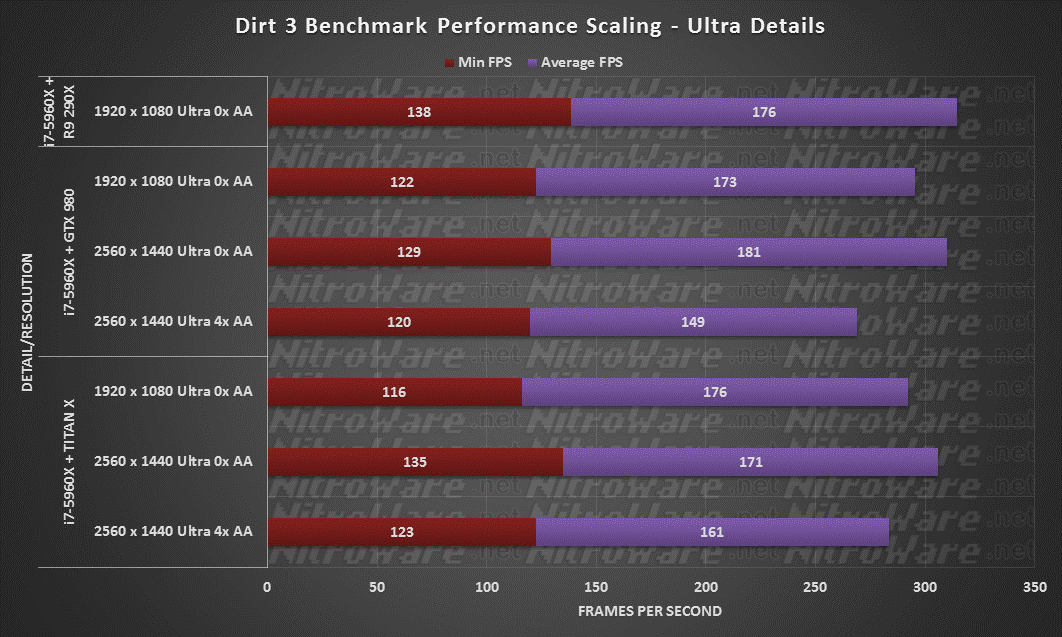
Dirt 3 from Codemasters is their 2nd generation of racing game utilising their EGO engine, incorporating DirectX 11 effects such as lighting, water and crowds. Again under AMD's Gaming Evolved banner the title is well multi-threaded and can utilise up to 8 CPU cores, allocating these to different functions of the game. It also scales well across different resolutions and CPUs making it an ideal test especially as it includes random opponent AI.
Despite this, the benchmark includes a random AI element which alters the result of the race each time the test is run. This and the nature of the game can induce variation into results. Regardless both of NVIDIA's GTX 980 and TITAN X are able to drive minimum of 120 FPS which is desirable for the new 1440p 120/144Hz gaming monitors incorporating smooth motion technology from AMD (Freesync)and NVIDIA (G-Sync), or 3D Stereoscopic gaming.
Batman: Arkham Origins Performance Scaling with and without GPU PhysX
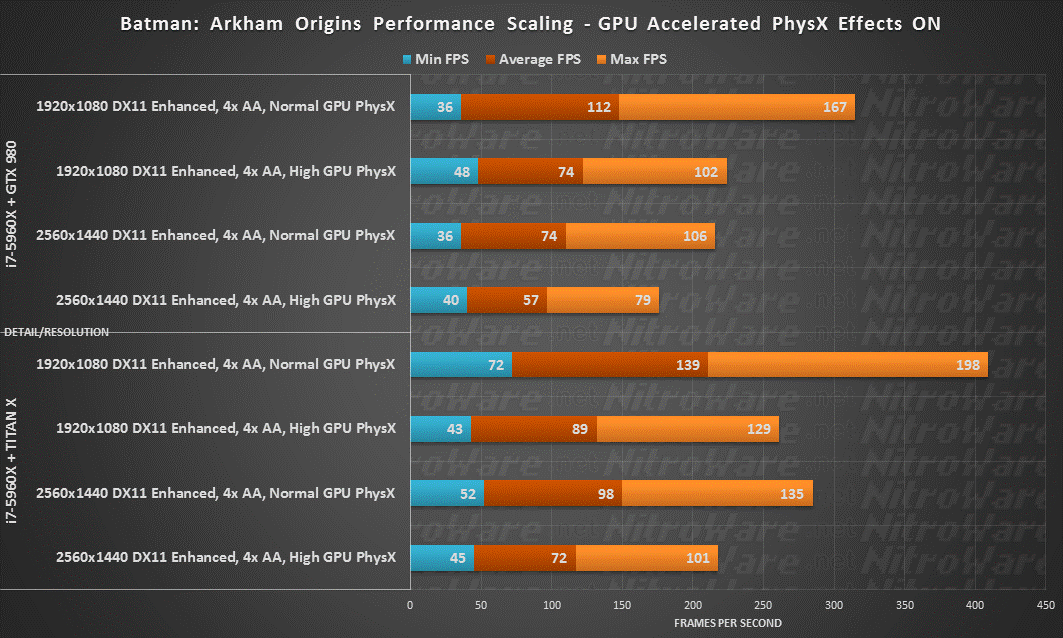
Being an NVIDIA The Way It's Meant To be Played branded title, of course the Batman Franchise of Games includes GPU Accelerated PhysX for NVIDIA GeForce cards.
For Arkham Origins there are three settings, OFF (CPU powered standard Physics only), Normal which gives GPU Accelerated PhysX mainly lots of interactive paper and banners in game and High, which is paper, banners, steam, smoke and snow.
GPU Accelerated PhysX is not free and has a significant performance penalty. Additionally it is not supported on AMD RADEON therefore we need to test multiple combinations of settings. Ideally an owner of a high end GeForce especially our TITAN X would like to play with everything maxed out and at 1440p with HIGH PhysX TITAN X delivers, 20% faster than a reference GTX 980.
We were not able to compare against the 290X here due to card failure.
Things to note was Arkham Origins was developed in-house at Warner Bros Game Studios and not Rocksteady who did the other three games and that even the menu screen for the game is very GPU intensive. Actually playing both Arkham City and Arkham Origins, the use of GPU PhysX effects is quite profound and noticeable such as in missions where you have to deal with ice when chasing the Penguin or back alleys full of all discarded paper flying in the breeze.
Some claim it is just visual eye candy, but being a fan of the series and having equally fully played and tested the batman games with and without extra GPU PhysX it is hard to do without the extra effects.

To be fair to RADEON users and for comparison purposes we also tested with GPU PhysX off. While it had a 30 FPS penalty enabled, we still have similar scaling between GPUs with it off, of 20 FPS.
Bioshock Infinite Performance Scaling
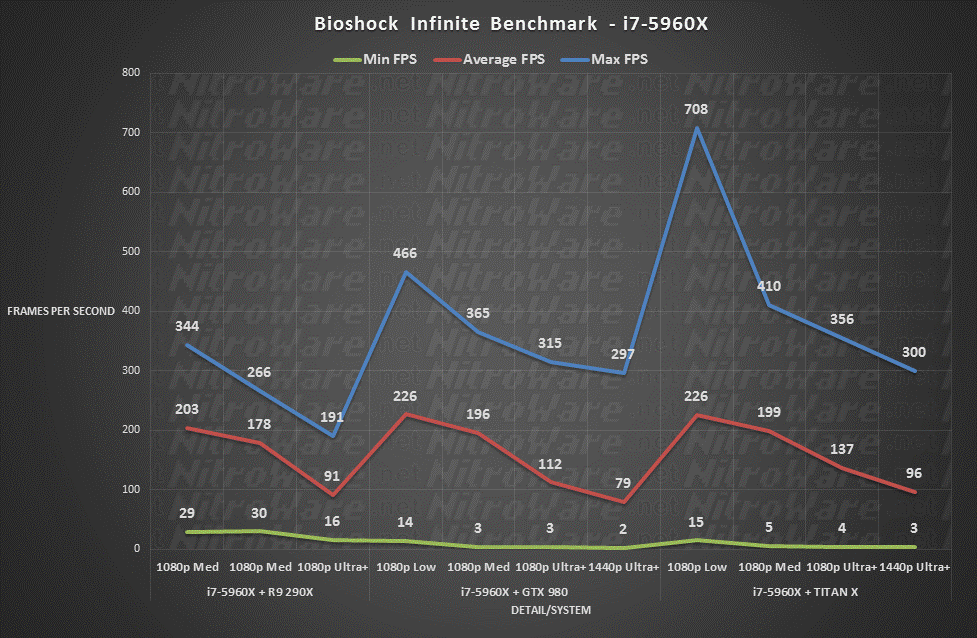
Another Gaming Evolved Title, we are dammed if we use this game and dammed if we don't. Although a popular title and widely used as a test due to its convenient benchmark mode, it has several flaws. Results can be inconsistent, there is no AI in the test it is simply a graphics fly through of popular levels from the game and there are calculation anomalies in the raw test results. Never the less we present Bioshock and likely the last time we use this test for high end PCs before retiring it.
For average, TITAN X delivers against the 290X, again unfortunately no 1440p for 290X due to failure.
Crysis and Crysis 3
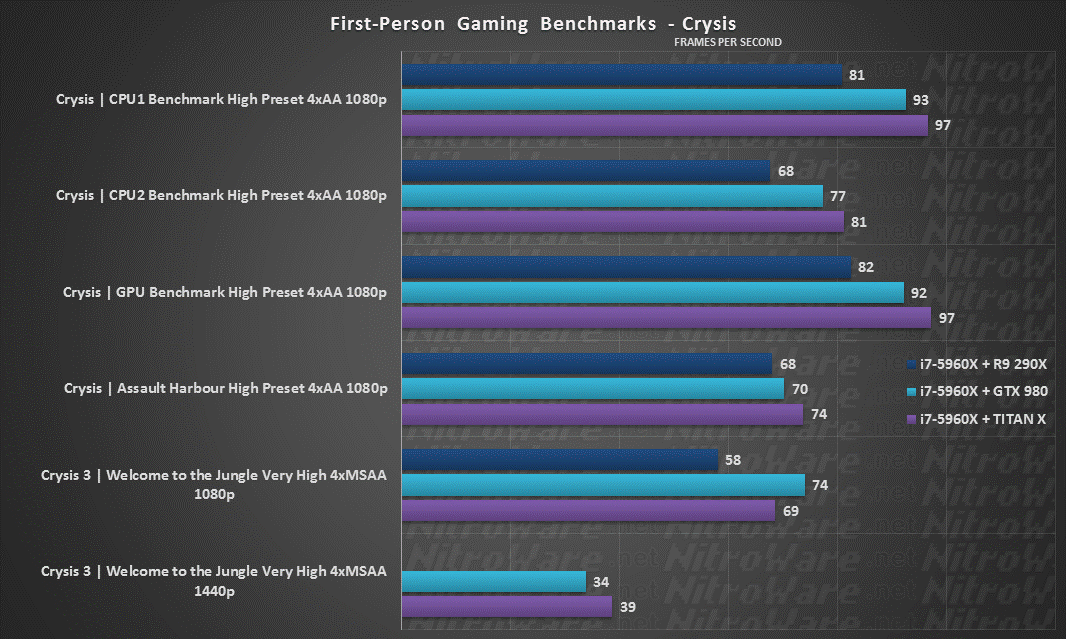
Can TITAN X play Crysis? hell yeah !
Our Crysis tests are fully automated and do not contain enemy AI, only damage physics or are level fly-throughs. Our Crysis 3 tests are manual, actual gameplay with the frame rate measured. This can be inconsistent as no two play-throughs will never be exactly the same. In a way this can be a good thing as its a realistic simulation of actual game play. Despite being 64-bit and DirectX 10 the original Crysis still performs moderately.
We standardise on MSAA for comparability, as Crysis 3 supports multiple types of AA which would be too complex and overwhelming to compare. We wish frame rates were higher for Crysis 3 at 1440p but at this level the effects are outstanding especially for the games age especially grass and foilage. However, Crysis 3 is not really a game were you want low frame rates.
Metro 2033 and Metro Last Light
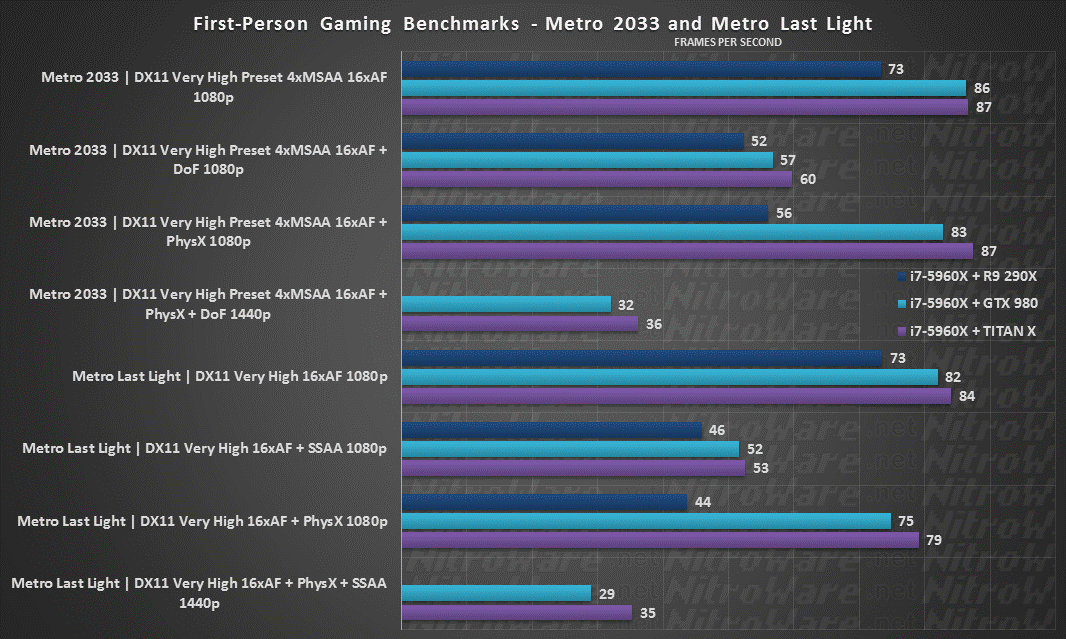
The original editions of both Metro 2033 and its sequel Last Light now share the throne with Crysis as very heavy demanding titles. Their benchmark routines feature AI, physics (GPU accelerated PhysX optional), collision damage and heavy particle effects. Again Super-Sampled AA almost halves the frame rate. The change from MSAA to SSAA between the games is interesting.
29 to 35 FPS at the high end may not seem like much but again that is actually a 20% increase. Both Metro games are NVIDIA logoed and marketed.
Alien v Predator, Battlefield 3, Deus Ex:Human Revolution, Sniper Elite V2
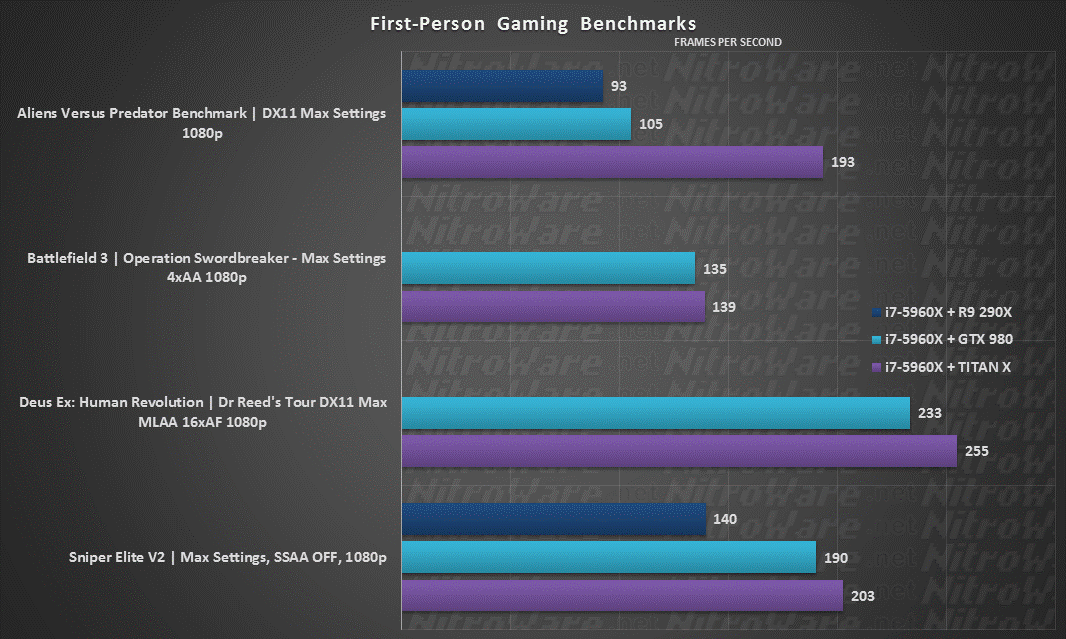
Alien V Predator 2009 is a standalone DirectX 11 benchmark that first debuted on AMD's 'Cayman' Radeon 6900 series GPU. Back then it was an eye-catching demo and still is now especially when scaled up to 4K. The benchmark routine includes scripted AI paths and some collisions.
Battlefield 3: the gold standard in Military First Person Shooters. We loop the start of gameplay in Operation Swordbreaker level through the first firefight manually using actual gameplay and FRAPS. Things to consider are variations in frame rate due to manual play, no two play-through would be the same.
Deus Ex Human Revolution was released in late 2011,and although it was suppose dto be graphically rich at launch things improved quickly and it runs too well these days. We benchmark the introduction of the game, Dr Reed's Tour using manual gameplay. This features character AI but no gunplay and minor collisions.
Sniper Elite V2 ships without a Multi-Sampled AA feature , only Super-Sampling at 2.25x or 4x. We benchmark without SSAA at 1080.
Clearly these older games are outclassed by flagship hardware, although in the case of Sniper Elite based on our 4K benchmark with Super-Sampled Anti-Aliasing which takes a huge performance hit, having a huge FPS number to begin with helps.
Batman Arkham City, Hitman Absolution, Resident Evil 5
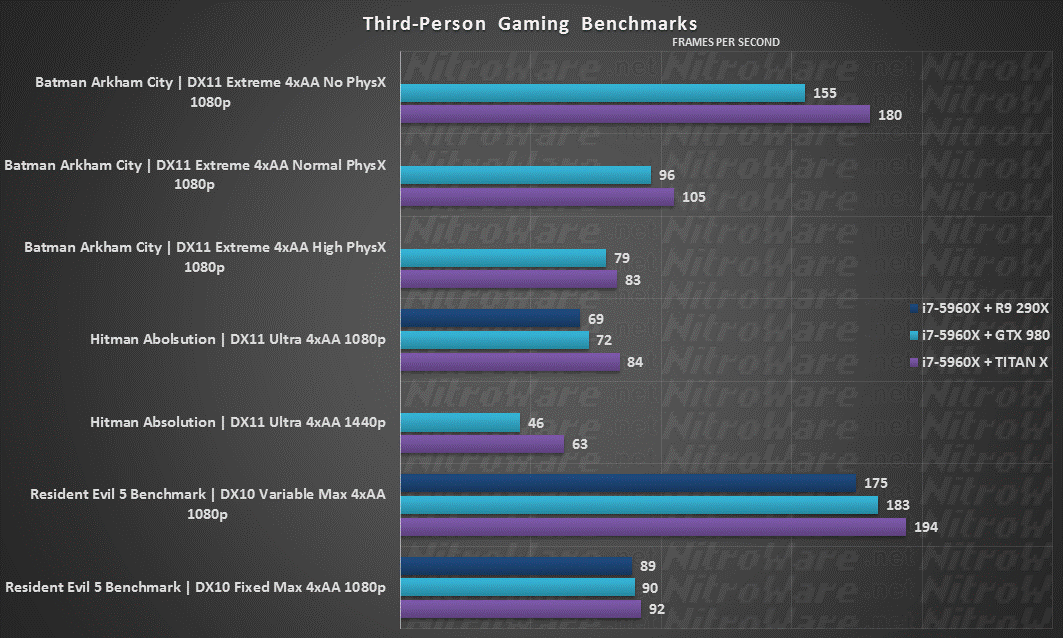
Arkham City was the 2nd in Warner Bros/Rocksteady's franchise of open world/3D all based on the Unreal Engine. Released in the NVIDIA 'Fermi' (GTX400/500 series) and branded under NVIDIA's game marketing program it had spectacular GPU PhysX and DX11 effects for its time yet was made infamous by reviewers for having an unusable DX11 mode at launch. With two sequels since (Arkham Origins and the at the time of this review delayed Arkham Knight), we have scaled back our testing of Arkham City and moved on to the newer titles in the franchise.
Hitman Absolution was a showcase title for AMD utilising GPU compute for some effects and combines both FXAA and MSAA. It's benchmark loop features heavy particle effects and Crowd instancing, despite sometimes giving inconsistent results, TITAN X gives a huge boost at 1440p which is what we want to see.
Resident Evil 5 is an older DX10 title which allows us to compare relative 3D performance across a range of entry to high end devices. You would typically run such titles in 'locked' frame mode, so it is important to achieve a constant frame rate, ideally 60 FPS at your chosen resolution.
Trackmania Nations Forever, Sleeping Dogs, Just Cause 2, Warthunder, Star Swearm
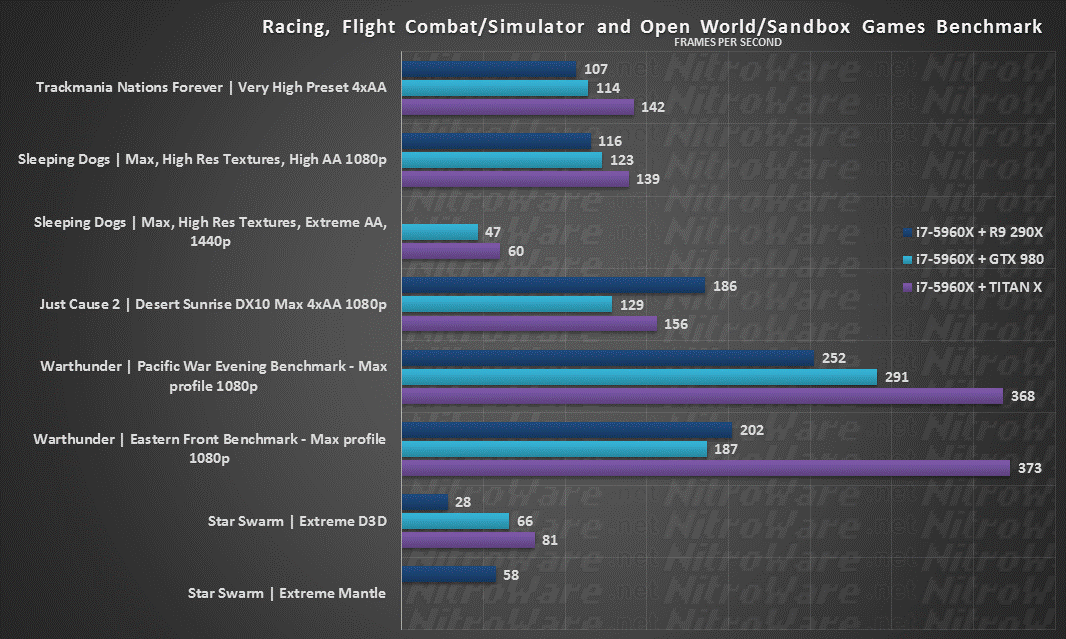
Trackmania is a DX9 free to play single and multi-player racer that is popular online and in professional e-sports. Being older (the newer commercial titles in the franchise have updates) it is not fully optimised for new hardware yet can still scale to 4K fine. TITAN X gives us the promised speed-up, though even it can only just achieve 144 Hz.
We talked about Sleeping Dogs under our 4K coverage but here we show 1080p and 1440p performance, Scaling is consistent between our three top end GPUs. Performance at 1440p Extreme is satisfactory and of course we could scale back down to Normal AA as shown in our 4K benchmark.
Just Cause 2 being an NVIDIA title includes some GEFORCE ONLY graphics features such as Bokeh filter and these may affect the frame rate. We test with these on as a worst case scenario and that the settings don't line up properly between GPUs. For such an 'old' title, it can correctly see our 12,288MB of video memory.
Recently endorsed by NVIDIA for including effects from its Gameworks library, Warthunder - a free to play air warfare title from Gaijin Entertainment presents us with a large number of graphical options. For 1080p we stick with the max preset for comparability,noting that max still does not fully utilise all the possible effects and details possible. At 4K we test with custom settings that do max these out.
Star Swarm is a benchmark created by Oxide Games to demonstrate AMD's 'close to the metal' MANTLE API which delivers improved efficiency when combined with their Radeon GPUs. Focusing on large numbers of star ships in combat, ironically a 290X and Mantle is outclassed by a GTX 980 in D3D mode, let alone the TITAN X.
Having said this, newer AMD drivers may have improved things but as we stated earlier our 290X couldn't take the stress of heavy benchmarking and died.
Street Fighter IV, Total War: SHOGUN 2, World In Conflict, Civilisation: Beyond Earth
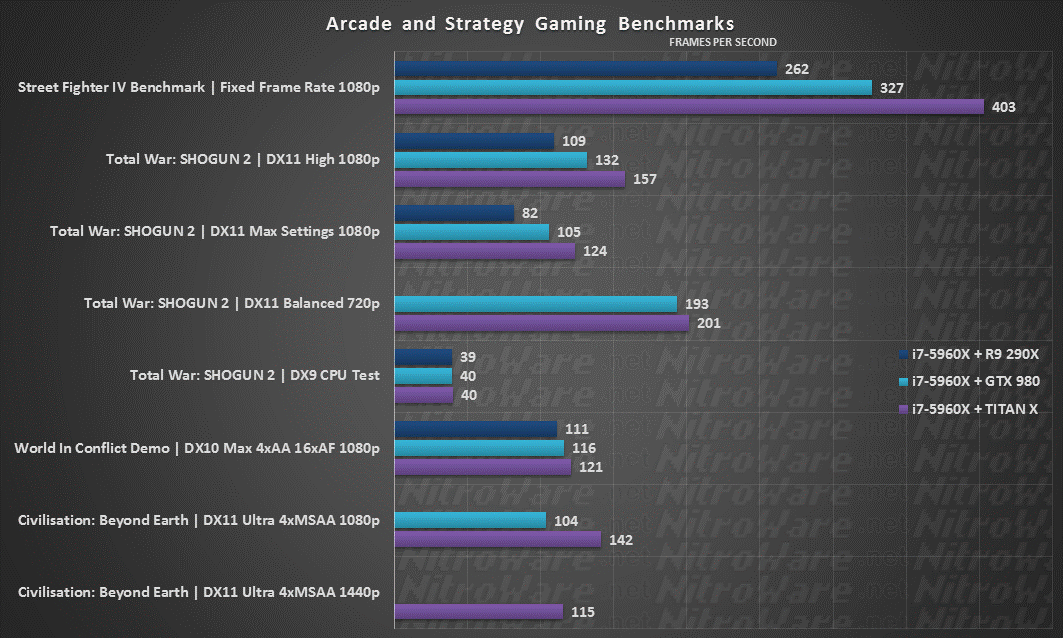
StreetFighter IV was designed for older hardware and fixed 60 FPS but can demonstrate to us the threshold of graphics throughput when we remove the frame rate lock/limiter. Ludicrous speed is achieved. For curiosity we tried at 4K, 8X MSAA and additional Ink effects and we still achieved 300 FPS.
The DX11 title SHOGUN 2 from Sega and Creative Assembly lets us compare different platforms by using its various benchmark profiles. The benchmarks include heavy unit AI and object instancing. Although focusing on GPU performance, we include the CPU test to show different motherboards are within spec, as we used two different X99 motherboards from Gigabyte and ASUS for this review.
World In Conflict was an early DirectX 10 RTS which incorporates heavy enemy AI, object destruction and particle effects. Both the WIC and SHOGUN 2 benchmarks replicate actual gameplay rather than just a fly-through and despite its age WIC is still some effort for our huge GPUs.
CIV:Beyond Earth is the new kid on the block here which was designed to test and showcase Mantle. Regardless its benchmark performs great on TITAN X in Direct3D mode.